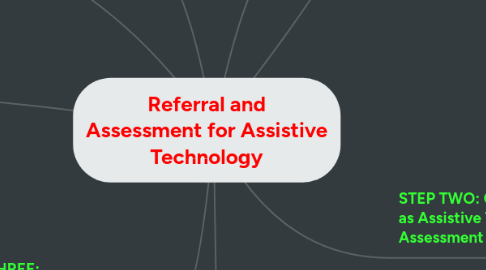
1. 1.) Support from related service personnel and the IEP team should be made available to the family, student and teacher in daily implementation of device.
2. 3.) Related service personnel and IEP team members should use available checklist as informal assessment of both the device and the student in regards to future decisions regarding AT implementation.
3. STEP FOUR: Implementation of the Assistive Technology Device
3.1. 2.) Special Education teacher should assess the device in association with assessment of student to ensure that device is working properly and serving the educational needs of the student.
4. STEP THREE: Individualized Education Program Team
4.1. Once the student is determined to be in need of AT, the team locates an available device. AT devices can be difficult to understand and use, so it is recommended to borrow one before purchase. The student, as well as all who will be involoved in the students' educational goals should be properly trained to use all devices.
5. Erica Brooks EDUC620 September 25, 2012
6. STEP ONE: Referral for Assistive Technology
6.1. Referral is made, team meets to overlook and consider information concerning the student. These items should be included, the more information provided, the better.
6.1.1. Student data/personal information
6.1.2. Medical information
6.1.3. Hearing/vision reports
6.1.4. Reports on any technology currently in use by student
6.1.5. Background information regarding services previously provided to student
7. STEP TWO: Conducting as Assistive Technology Assessment
7.1. Direct Observation
7.1.1. Cognitive skills
7.1.2. Current use of AT devices
7.1.3. Sensory skills
7.1.4. Motor skills
7.1.5. Communication skills
7.1.6. Sensory skills
7.2. Interviews
7.2.1. Family expectations of student
7.2.2. Percieved needs and abilities of student
7.2.3. Academic expectations
7.2.4. Diagnostic information
7.2.5. Medical information
7.2.6. Independent living/vocational skills (for older children)
7.3. Formal Assessment
7.3.1. This step usually includes activities in predetermined environments. Standard AT tools may or may not be applicable to assessment
7.4. Final Organization
7.4.1. All information gathered will provide The AT professional with a comprehensive picture of the students' strengths and needs. Final report formatiing will vary according to district.
